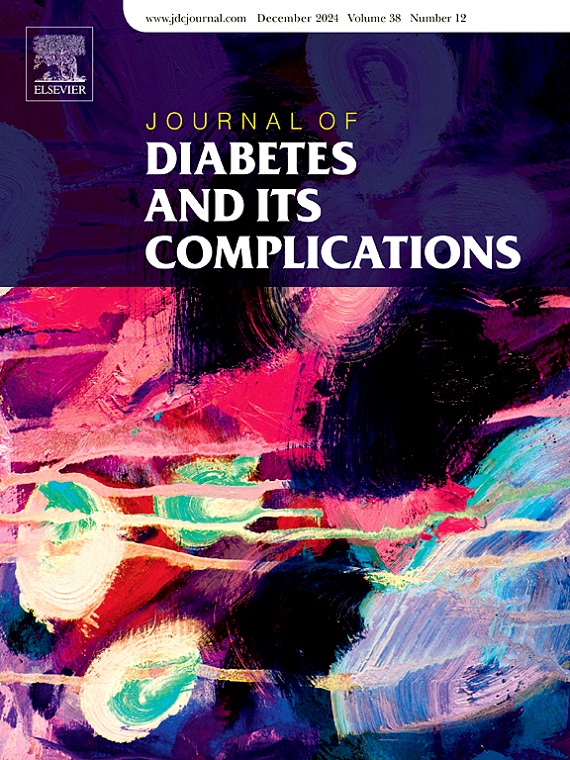Atypical complications and co-morbidities of type 1 diabetes in young adults
IF 3.1
3区 医学
Q3 ENDOCRINOLOGY & METABOLISM
引用次数: 0
Abstract
Aims
Our review aimed to determine the prevalence of – and factors associated with – hearing loss, oral and olfactory disease, frozen shoulder, trigger finger, and hair loss in young adults with type 1 diabetes. These conditions were selected based on research team interests, existing literature, and group discussion.
Methods
We conducted a quantitative narrative review using a systematic process to identify cohort and cross-sectional studies involving young adults with type 1 diabetes (mean age 18–30 years). PubMed, CINAHL, and Cochrane were searched (January 2000–February 2024). Grey literature was not restricted, and quality appraisal was undertaken. Extracted data were synthesised and summarised narratively.
Results
The initial search found 3924 records and after title, abstract and full-text review, 19 records met inclusion criteria. Hearing loss prevalence ranged from 22.6 to 48.0 %, with age, diabetes duration, and systolic blood pressure identified as prominent associated features. For oral disease, peridontitis prevalence was 4.7 %, while alveolar bone loss ranged from 24.6 to 43.9 %; age was the primary associated factor. No eligible data were identified regarding frozen shoulder, trigger finger, or hair loss.
Conclusions
Further research is needed to characterize the prevalence and risk factors of atypical complications in type 1 diabetes. Clinical care should be guided by a robust understanding of these under-recognised comorbidities.
年轻人1型糖尿病的非典型并发症和合并症
目的:本综述旨在确定年轻1型糖尿病患者听力损失、口腔和嗅觉疾病、肩周炎、扳机指和脱发的患病率及其相关因素。这些条件是根据研究小组的兴趣、现有文献和小组讨论选择的。方法:我们采用系统的方法进行定量叙述性回顾,以确定涉及年轻1型糖尿病患者(平均年龄18-30岁)的队列和横断面研究。检索PubMed, CINAHL和Cochrane(2000年1月- 2024年2月)。不限制灰色文献,进行质量评价。对提取的数据进行综合和叙述总结。结果初步检索到3924篇文献,经标题、摘要和全文审核,符合纳入标准的文献有19篇。听力损失的患病率从22.6%到48.0%不等,年龄、糖尿病病程和收缩压被认为是显著的相关特征。口腔疾病方面,牙周炎患病率为4.7%,而牙槽骨丢失率为24.6%至43.9%;年龄是主要的相关因素。没有关于肩周炎、扳机指或脱发的合格数据。结论1型糖尿病非典型并发症的患病率及危险因素有待进一步研究。临床护理应以对这些未被充分认识的合并症的充分了解为指导。
本文章由计算机程序翻译,如有差异,请以英文原文为准。
求助全文
约1分钟内获得全文
求助全文
来源期刊

Journal of diabetes and its complications
医学-内分泌学与代谢
CiteScore
5.90
自引率
3.30%
发文量
153
审稿时长
16 days
期刊介绍:
Journal of Diabetes and Its Complications (JDC) is a journal for health care practitioners and researchers, that publishes original research about the pathogenesis, diagnosis and management of diabetes mellitus and its complications. JDC also publishes articles on physiological and molecular aspects of glucose homeostasis.
The primary purpose of JDC is to act as a source of information usable by diabetes practitioners and researchers to increase their knowledge about mechanisms of diabetes and complications development, and promote better management of people with diabetes who are at risk for those complications.
Manuscripts submitted to JDC can report any aspect of basic, translational or clinical research as well as epidemiology. Topics can range broadly from early prediabetes to late-stage complicated diabetes. Topics relevant to basic/translational reports include pancreatic islet dysfunction and insulin resistance, altered adipose tissue function in diabetes, altered neuronal control of glucose homeostasis and mechanisms of drug action. Topics relevant to diabetic complications include diabetic retinopathy, neuropathy and nephropathy; peripheral vascular disease and coronary heart disease; gastrointestinal disorders, renal failure and impotence; and hypertension and hyperlipidemia.
 求助内容:
求助内容: 应助结果提醒方式:
应助结果提醒方式:


